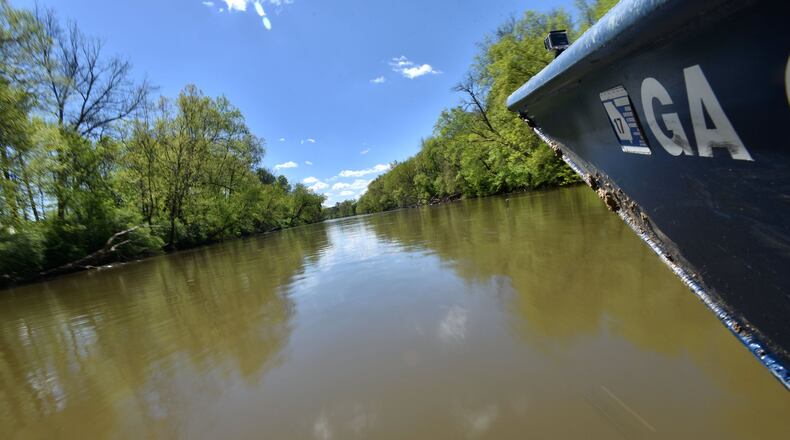The U.S. Supreme Court on Wednesday directed an expert judge to revisit key aspects of Florida’s water rights case against Georgia, a disappointing legal outcome for the Peach State after it racked up several recent victories in court related to its long-running water dispute with its neighbors.
The justices in their 5-4 opinion told Ralph Lancaster Jr., the so-called "special master" who recommended last year that the court dismiss Florida's case, to conduct further legal proceedings in the battle over water from the Apalachicola-Chattahoochee-Flint river basin, which originates in North Georgia and follows along the Alabama border to the Florida Panhandle.
Writing for the majority, Justice Stephen Breyer concluded that Lancaster initially "applied too strict a standard" when he determined the court could not find an "equitable" solution that would lead to more water flowing downstream from Georgia.
“The amount of extra water that reaches the Apalachicola may significantly redress the economic and ecological harm that Florida has suffered,” said Breyer, who was joined by Chief Justice John Roberts and Justices Anthony Kennedy, Ruth Bader Ginsburg and Sonya Sotomayor. “Further findings, however, are needed.”
PDF: Read the complete decision
After hearing five weeks of testimony, Lancaster said in his February 2017 ruling that there were no legal remedies available because Florida did not include the U.S. Army Corps of Engineers, which oversees water flow in the country's locks and dams, as a party to its case.
Justice Clarence Thomas, a Georgia native, wrote in a blistering dissent that it “makes little sense” to send the case back to Lancaster. The special master, he said, has already sifted through more than 7 million pages of documents and conducted nearly 100 depositions.
“Giving Florida another bite at the apple will likely yield no additional evidence, but it will be unfair to Georgia, which has already spent the time and resources to defeat the case that Florida chose to present,” he said.
“In short, we have all the evidence we need to decide this case now,” Thomas added.
‘Huge win’
The court’s opinion — the last to be released from its 2017-2018 term — does not go as far as prescribing a specific solution for the water battle such as limiting Georgia’s water use, nor does it guarantee Florida a future victory against Georgia at the high court. But it does keep Florida’s legal challenge alive.
Florida Gov. Rick Scott quickly declared victory, calling the court’s ruling a “huge win” for his state.
“For nearly thirty years and under five governors, Florida has been fighting for its fair share of water from Georgia,” said Scott, who is running for the U.S. Senate this year. “I am glad that the court ruled in Florida’s favor today and we look forward to further securing a healthy Apalachicola Bay while protecting the thousands of jobs that depend on this natural resource.”
Georgia Gov. Nathan Deal responded with his own press release stating that he remained “confident” in the state’s legal position.
“Georgia heeded the Special Master’s warning and took legislative action, which is now law, to address his concerns,” the Republican said. “I look forward to continuing to defend our position in this case.”
Deal, Scott and Alabama officials had huddled at various points over the past eight years to strike their own accord outside of court. But those efforts proved to be fruitless, and Deal recently listed the lack of a tri-state agreement as one of his biggest regrets while in office.
Three-decade fight
The Florida-Georgia case marks the first time the Supreme Court has gotten involved in Southeastern water wars, which have raged for nearly three decades. The battles have pitted Georgia against Florida and its frequent ally, Alabama, and have cost the parties involved tens of millions of dollars.
Georgia alone has spent more than $47 million of taxpayer money on litigation over the Apalachicola-Chattahoochee-Flint (ACF) river basin since Deal took office in 2011, said Chris Riley, Deal’s top aide.
Florida filed its case with the Supreme Court five years ago following the collapse of its oyster industry in the Apalachicola Bay. It argued the water usage of metro Atlanta and southwest Georgia farms upstream had aided the bay's ecological and economic decline. Florida's attorney argued before the justices that the state "suffered real harm" at the hands of Georgia and that the justices should impose a cap on Georgia's water usage at roughly 1992 levels — when metro Atlanta was home to only half as many people as it is today — so more water can flow downstream.
Read more:Supreme Court wades into Georgia's long-running water rights battle
Alabama was not a party to the case but aligned itself with Florida.
Georgia countered that its water use had little to do with the collapse of the oyster industry and argued the justices should uphold Lancaster’s recommendations — which essentially handed Georgia a victory based on a technicality. They said the state has been a responsible steward of its water, cutting down on consumption in metro Atlanta even as the region’s population has exploded. And they warned that capping the state’s water usage would have a devastating impact on Georgia’s economy, costing some $18 billion.
Even though Lancaster suggested that the justices dismiss Florida's challenge, he did excoriate Georgia for not being a more responsible steward of its water, particularly within its agriculture sector. And he urged the governors of Georgia, Florida and Alabama to strike a congressionally approved compact dictating water usage in order to avoid a costly legal fight.
Katherine Zitsch, manager of natural resources at the Atlanta Regional Commission, said Wednesday that the group is “disappointed this litigation will continue.”
“But we are confident that metro Atlanta’s water use is reasonable,” she said. “Metro Atlanta is a national leader in water conservation and uses on average only 1.3 percent of the water in the ACF basin to support a thriving region of more than 5 million people and 2.5 million jobs.”
Republican U.S. Rep. Neal Dunn, whose coastal Florida district is home to the Apalachicola Bay, said the court’s ruling essentially recognizes that “Florida has been harmed as a result of decreased water flow to the ACF river basin.”
In addition to the Supreme Court battle, three additional cases related to the ACF and the nearby Alabama-Coosa-Tallapoosa river basin are currently winding their way through the federal court system.
A parallel fight on Capitol Hill involving lawmakers from the three states will almost certainly continue to play out, especially now that Alabama's senior senator is the new chairman of the powerful Senate Appropriations Committee.
Water wars timeline
1956: The U.S. Army Corps of Engineers completes construction of the earthen Buford Dam, impounding the Chattahoochee River to form the 38,000-acre Lake Lanier. One of the corps' main functions is to operate three hydroelectric turbines that supply power to the region.
The cities of Buford, Cumming and Gainesville, as well as Forsyth and Gwinnett counties, draw water out of the lake. Cobb, DeKalb and Fulton counties get water from pumping stations on the Chattahoochee after the water passes through the dam’s turbines.
1960s: The corps allows the metro area to increase its water withdrawals from the Chattahoochee River because the intakes did not affect the dam's hydroelectric operations.
1975: The corps determines that it could supply an average of 230 million gallons of water per day to metro Atlantans without it affecting hydropower generation.
1986: The corps determines that it could supply an average of 327 million gallons of water per day to metro Atlantans without it affecting hydropower generation.
1989: The corps releases a proposal for a new operating manual for Buford Dam that calls for significantly increasing the amount of water that could be used to meet the area's needs.
1990: The corps scuttles its plan to make more water available as water supply after Alabama files the first of four lawsuits challenging metro Atlanta's withdrawals from Lake Lanier.
1997: Georgia, Alabama and Florida agree to form a commission to figure out an allocation formula. The pact includes a "live and let live" provision that allows the corps to honor existing water supply contracts and permits water systems to increase their withdrawals to satisfy "reasonable" increases in demand. The agreement dissolves in 2003 when the commission cannot agree on a formula.
2000: Georgia asks for increased withdrawals to meet Atlanta's needs through 2030. The request is denied.
2009: A federal judge signs an order that would severely restrict Atlanta's water withdrawals unless Alabama, Florida and Georgia strike a water-sharing deal. U.S. District Judge Paul Magnuson said that Lake Lanier was not intended as a water supply for metro Atlanta. The intended purposes were hydropower, navigation and flood control, he said. Magnuson gave the states three years to work out an agreement before the order would take effect, limiting metro Atlanta to withdraw water at the same levels as it did in the mid-1970s.
June 28, 2011: An appeals court overrules Magnuson's decision, saying supplying metro Atlanta water was an intended use for the lake.
June 25, 2012: The U.S. Supreme Court secures metro Atlanta's claim to water from Lake Lanier when the court turns down appeals from Alabama and Florida.
Oct. 1, 2013: Florida asks the U.S. Supreme Court to order Georgia to let more Chattahoochee River water flow into the Panhandle to keep the state's oyster industry afloat. The suit asks that metro Atlanta's withdrawals from Lake Lanier and the Chattahoochee River be held to the same levels as 1992, when the region drew about 275 million gallons a day to serve 3 million. The level in 2013, following a 55 percent increase in the region's population since 1992 to 5.4 million, was about 360 million gallons a day.
Nov. 3, 2014: The U.S. Supreme Court agrees to hear a Florida lawsuit that seeks to cap Georgia's withdrawals from the Chattahoochee River.
September 2015: The corps updates its water-sharing plan for the Chattahoochee River for the first time since 1989. The plan, which requires final approval, would allow Georgia by 2040 to tap nearly 600 million gallons each day from the Chattahoochee River and Lake Lanier.
November 2015: Georgia and Florida agree to enter mediation in an attempt to reach an agreement on sharing water. Mediation will not succeed.
April 2016: American Rivers, a national environmental group, declares the Chattahoochee River basin as the nation's "most endangered" waterway. It cited a generation's worth of water-sharing fights between Georgia, Alabama and Florida, outmoded river management by the corps and the ever-looming chance of drought as evidence of the basin's precariousness.
Oct. 31, 2016: The Florida v. Georgia water war trial begins in a Maine courtroom with Ralph Lancaster, the attorney the Supreme Court appointed as special master to oversee the case, presiding.
December 2016: The Florida v. Georgia water wars trial in Maine ends. Also in December, the corps rules that Forsyth, Gwinnett and Hall counties may withdraw 242 million gallons daily from Lake Lanier. The city of Atlanta and Cobb, DeKalb and Fulton counties would get an additional 379 million gallons daily from Lake Lanier and the Chattahoochee – enough water to slake population demands through 2050. Metro Atlanta currently taps about 360 million gallons a day from the Chattahoochee.
Feb. 14, 2017: Lancaster rules that Florida failed to prove that new limits on Georgia's water consumption were needed.
Jan. 8, 2018: The Supreme Court hears oral arguments from Florida's water rights case against Georgia.
About the Author
Keep Reading
The Latest
Featured




